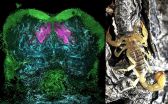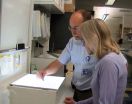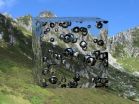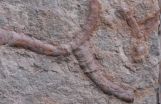(Press-News.org) LA JOLLA, CA--December 18, 2014--Collaborating scientists from The Scripps Research Institute (TSRI) and the University of California (UC) San Diego have developed a powerful new system for studying how proteins and other biological molecules form and lose their natural folded structures.
Using the new system, researchers can force a sample of molecules to unfold and refold by boosting and then dropping the temperature, so quickly that even some of the fastest molecular folding events can be tracked.
"One way of studying these structures has been to make them unfold or fold using heat and to observe the kinetics and other properties of those unfolding and folding events," said TSRI Associate Professor Ashok A. Deniz. "The new system allows us to do this in a way that overcomes some key limitations of previous methods."
The invention can be applied to the study not only of normal biomolecules, but also many abnormal, misfolding ones that have been implicated in human diseases.
The findings of Deniz's laboratory and the laboratory of a close collaborator, biophysicist Alex Groisman at UC San Diego, are reported in Nature Communications this week.
Too Small, Too Fast
Studying how proteins, DNA and other biological molecules fold is one of the most challenging areas of biology, in particular because these tiny molecules--tinier than the wavelengths of visible light--can fold or unfold in intervals as short as a few millionths of a second (microseconds).
Researchers in this field have come up with some powerful innovations in the past decade or so, including the use of exotic quantum optical phenomena to track fast molecular motions. But techniques for perturbing folded molecules with sudden temperature changes have lagged. "The size of temperature jumps has been limited to about 15 degrees Celsius, and we've lacked a way to cool samples quickly back to room temperature," said Deniz.
In the new study, the Deniz and Groisman laboratories teamed up to develop a device that overcomes both limitations. Their microfluidic device, like others that have been developed in this field, is a small block of silicone fabricated with tiny channels through which a biomolecule-containing solution can flow. In this case, the observation channel is less than a millionth of a meter deep, is lined with sapphire for conducting heat away quickly and also contains a thin gold plating for effectively absorbing power of an infrared laser beam and converting it into heat.
The combination of the small heating volume and the energy-absorbing gold plating means that the laser can heat a sample of molecules very rapidly, with a temperature jump of more than 50 degrees Celsius in less than a microsecond. The heat-conducting sapphire substrate in turn allows the sample to cool down by several tens of degrees, again within about a microsecond, as soon as the laser is switched off.
Novel Demonstrations
As a simple proof of the new device's utility, the researchers used it to heat and cool a solution of a short DNA strand that naturally forms a hairpin-shaped loop. Hairpin DNA are dynamic structures that play key roles in cellular replication and other important biological processes.
The experiment, which included fluorescence techniques for detecting folded-versus-unfolded states of the DNA strand, revealed that the hairpin fold can form in just a few microseconds. "We could not have observed such a rapid folding with previous temperature-jump systems, which typically take thousands of microseconds to cool molecules," said Priya R. Banerjee, a research associate in Deniz's laboratory who was a first author of the report with Mark E. Polinkovsky of Groisman's laboratory, and Yann Gambin, also a member of Deniz's laboratory during the study. In addition, the scientists used the new setup to study a larger DNA hairpin, together confirming previously predicted behavior about the differential effect of sodium chloride--ordinary salt--on the folding and unfolding kinetics of different-sized hairpins.
In a final demonstration of the novel capabilities of their new setup, the scientists were able to probe how the molecular system behaved as a low-pass filter, in some ways similar to ones in electronics or cellular circuits. The team used the ability to switch the heating laser on and off rapidly, combined with the rapid heating and cooling features of the new system, enabling new kinds of studies of molecular folding landscapes. Essentially, researchers can now subject a solution of molecules to a continuous series of heating and cooling cycles, altering the frequency and temperature range of this heating/cooling oscillation at will and observing how the molecules' unfolding/refolding dynamics change.
"We anticipate that this type of experiment will allow us to detect more complex or hidden features of biomolecule structural landscapes that haven't been seen before," said Deniz.
Deniz and his colleagues now plan to use their new system to study the folding dynamics of other molecules, including misfolding-prone proteins that can cause common human illnesses such as Alzheimer's, Parkinson's and Huntington's disease.
INFORMATION:
In addition to Deniz, Groisman, Banerjee, Gambin and Polinkovsky, Michael J. Erickstad of UC San Diego was an author of the study, "Ultrafast Cooling Reveals Microsecond-Scale Biomolecular Dynamics" (doi: 10.1038/ncomm6737). For more information, see http://www.nature.com/ncomms/2014/141217/ncomms6737/full/ncomms6737.html
Support for the research was provided by the National Science Foundation (MCB 1121959 and PHY 0750049).
Whether you're cramming for an exam or just trying to remember where you put your car keys, learning and memory are critical functions that we constantly employ in daily life.
It turns out that the structure and function of brain centers responsible for learning and memory in a wide range of invertebrate species may possibly share the same fundamental characteristics, according to a new study published in the journal Current Biology and performed by University of Arizona neuroscientists Nicholas Strausfeld, Regents' Professor in the Department of Neuroscience, part of ...
ST. LOUIS - Saint Louis University research findings published in the December issue of Antimicrobial Agents and Chemotherapy report a family of molecules known as nucleotidyltransferase superfamily (NTS) enzyme inhibitors are promising candidates for new herpes virus treatments.
The findings could lead to new treatment options for herpes that patients can use in conjunction with or instead of currently approved anti-viral medications like Acyclovir. Researcher Lynda A. Morrison Ph.D., professor of Molecular Microbiology and Immunology at Saint Louis University, likened ...
Why are older people at higher risk for developing cancer? Prevailing opinion holds that, over time, your body's cells accumulate DNA damage and that eventually this damage catches up with the body in a way that causes cancer. A University of Colorado Cancer Center study published today in the journal Aging shows that this prevailing opinion is incomplete. In addition to DNA damage, cancer depends on the slow degradation of tissue that surrounds cancer cells, something that naturally comes with aging.
"It's really all about natural selection and survival of the fittest," ...
Illinois is the most critical hub in the network of U.S. domestic food transfers, according to a new study by Megan Konar, an assistant professor of civil and environmental engineering, and colleagues at the University of Illinois at Urbana-Champaign. The study was published in the journal Environmental Science and Technology.
Much like the national airport network in which O'Hare International Airport is a major hub, Illinois plays the most central role in distributing food across the U.S. According to the report, the U.S. food network moves more than 400 million tons ...
Doctors and nurses are traditionally thought to be the primary caretakers of patients in a typical hospital setting. But according to a study at the burn center intensive care unit at Loyola University Health System, three physicians, a social worker and a dietitian were documented as the most central communicators of the patient clinical team.
David Shoham, PhD, and colleagues were published in the American Burn Association's Journal of Burn Care & Research. Shoham is an associate professor in the Department of Public Health Sciences of Loyola University Chicago Stritch ...
Chicago, December 17, 2014--A poll of the Russian public, conducted by The Associated Press-NORC Center for Public Affairs Research, was released today. The poll, which includes a nationally representative in-person survey of 2,008 Russian adults taken between November 22 and December 7, 2014, found that President Vladimir Putin is extremely popular. Few say the economy is in good condition and most say that sanctions are hurting the Russian economy. Despite economic woes, most Russians believe their country is headed in the right direction. Most respondents are also optimistic ...
WASHINGTON, D.C., December 18, 2014 -- Uncork a bottle of champagne, and as the pressure of the liquid is abruptly removed, bubbles immediately form and then rapidly begin the process of "coarsening," in which larger bubbles grow at the expense of smaller ones.
This fundamental nonequilibrium phenomenon is known as "Ostwald ripening," and though it is most familiar for its role in bubbly beverages, it is also seen in a wide range of scientific systems including spin systems, foams and metallic alloys.
On a much larger scale, Ostwald ripening can be observed in a power-generating ...
Cilia, the cell's tails and antennas, are among the most important biological structures. They line our windpipe and sweep away all the junk we inhale; they help us see, smell and reproduce. When a mutation disrupts the function or structure of cilia, the effects on the human body are devastating and sometimes lethal.
The challenge in diagnosing, studying and treating these genetic disorders, called ciliopathies, is the small size of cilia -- about 500-times thinner than a piece of paper. It's been difficult to examine them in molecular detail until now.
Professor ...
COLUMBIA, Mo. - A new study from University of Missouri and Virginia Tech researchers is challenging accepted ideas about how ancient soft-bodied organisms become part of the fossil record. Findings suggest that bacteria involved in the decay of those organisms play an active role in how fossils are formed--often in a matter of just a few tens to hundreds of years. Understanding the relationship between decay and fossilization will inform future study and help researchers interpret fossils in a new way.
"The vast majority of the fossil record is composed of bones and ...
New Rochelle, NY, December 18, 2014--Internet addiction is an impulse-control problem marked by an inability to inhibit Internet use, which can adversely affect a person's life, including their health and interpersonal relationships. The prevalence of Internet addiction varies among regions around the world, as shown by data from more than 89,000 individuals in 31 countries analyzed for a study published in Cyberpsychology, Behavior, and Social Networking, a peer-reviewed journal from Mary Ann Liebert, Inc., publishers. The article is available free on the Cyberpsychology, ...





